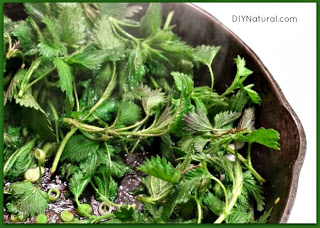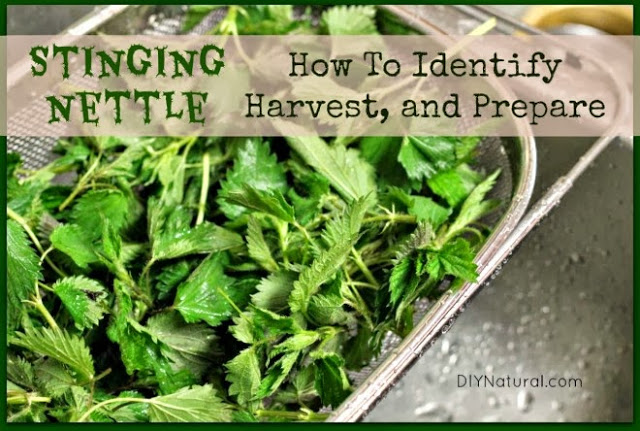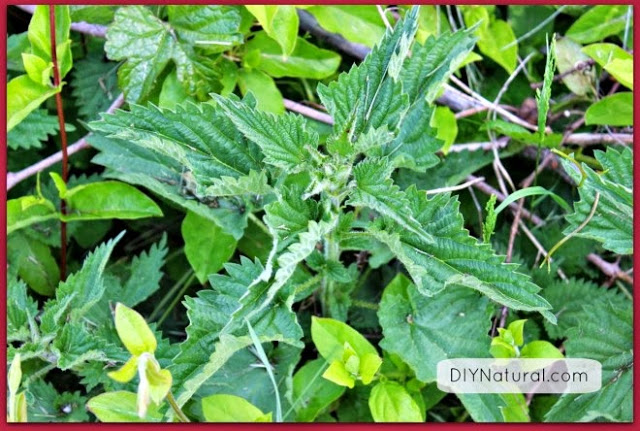Stinging Nettle: How To Identify, Harvest, and Eat
It’s unbelievable how much food you can collect from the wild! Our society is so accustomed to running to the grocery store for food that foraging for wild edibles has become a novelty instead of a necessity. Our ancestors not only knew how to identify wild plants that were edible, but they also wisely used this free bounty of nature.
Now that we’re learning more about edible wild plants, we have had several meals and snacks made up of weeds, plants, berries, and vegetables we harvested while out walking. (And no, we didn’t have to steal them from anyone’s yard!) Recently we had a beautiful salad with chickweed and dock, embellished with some of our favorite salad toppings. But one of our new spring favorites is sautéed stinging nettles with pasta or veggies.
Why stinging nettles?
Stinging nettle definitely lives up to its name – it will sting like crazy if you brush up against it or handle the plants without wearing gloves. But this nuisance of a plant is highly nutritious and readily available in most areas, making it one of the perfect wild plants to consume.
When cooked or dried, nettles completely lose their stinging properties, making them perfectly safe for consumption. You can steam, sauté, or boil them and enjoy with a meal or in soups. You can also make a wonderful tea with the leaves, sweetening with honey and lemon. Use them in any dish you would normally use spinach. They have an earthy, wholesome flavor that you’re sure to enjoy if you enjoy other greens.
Stinging nettles are also packed with nutrients. They are high in Vitamin C, Vitamin A, and full of calcium, magnesium, iron, and potassium. Nettles are also a wonderful source of protein. Seriously!
Finding and harvesting stinging nettles
Nettles will begin popping up in early spring, and can be found all across North America. Its proper habitat is in sunny places where there is rich, moist soil. You’ll find them growing along rivers, streams, lakes, ditches, fencerows, and on the edges of cultivated farm fields. When Matt and I walk along one of the nearby rivers, we always notice it growing abundantly as a “weed.”
Stinging nettle will grow in dense clusters, and stalks can reach 5-8 feet at maturity. Leaves are about 2-5 inches long with jagged edges, found in opposing pairs along the upper half of the stalk. Leaves are pointed at the tips, with a heart-shaped base and indented veins. The plant will have small “hairs” up the stalk and stems. (This is where the sting comes from!) Young plants will have smaller, heart-shaped leaves with a purple-ish hue, while the mature plants have longer, pointed leaves that appear very green. (For more pictures, click here.)
The best time to harvest nettles is the first few weeks after they come up in the spring, before they grow to be a foot tall. Wearing gloves, pick the first two or three pairs of leaves from the tops of plants. Carefully place nettles into a paper or plastic bag for transport. Nettles can still be harvested into summer, but keep in mind the top few pairs of leaves will be most tender, and stalks and stems will be very fibrous.
Once you are ready to use your nettles, use kitchen tongs to remove from the bag and place in a colander to rinse well. To avoid stinging, continue using tongs as you transfer your nettles from the sink to the stove.
Sautéed Nettles With Onions and Pasta
(Makes 2-3 servings)
You will need:
- 8 cups stinging nettles, rinsed well and chopped into smaller pieces if desired (use tongs while rinsing and dealing with nettles)
- ½ cup spring onions or ramps, sliced
- 2 Tbsp butter, preferably pastured
- 2 Tbsp other fat, like bacon grease, coconut oil, lard, etc. (we like bacon grease)
- ½ cup cooked ham, cubed (optional)
- 1 cup noodles, uncooked
- sea salt and fresh cracked pepper to taste
- freshly grated parmesan

Directions:
Boil water and cook noodles. Strain noodles, add a little olive oil to prevent sticking, and set aside. Melt fats in a large skillet on medium heat. Add spring onions and sauté for a few minutes. Using tongs, carefully add nettles to skillet and toss in fat and garlic until cooked down. Add optional cubed ham and toss until warm. Add noodles and gently toss all ingredients together to combine. Season with salt and fresh cracked pepper to taste. Garnish with freshly grated parmesan and enjoy!
We eat this as a complete meal, but it can also be served as a side dish.
Spring is the perfect time to find tender stinging nettles, so start foraging and take advantage of this natural free food source!
We highly recommend these books if you’re interested in learning more about edible wild plants:


